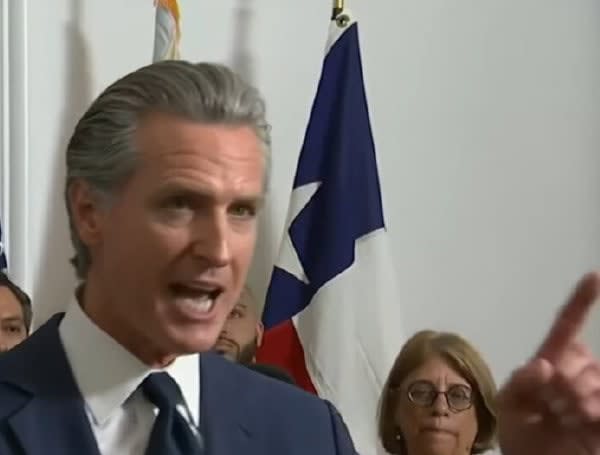
By Audrey Streb, DCNF. California Gov. Gavin Newsom
Some artificial intelligence (AI) data centers are vacant in California because the local utility cannot provide the electricity required to operate them, according to Bloomberg.
Although developers in Santa Clara, California, have completed the shells of data center projects, the facilities remain empty and unpowered because the city-owned utility, Silicon Valley Power (SVP), cannot supply enough electricity to meet their energy demands, Bloomberg reported.
California imports the second-largest amount of electricity of any state, according to the Energy Information Administration ([EIA](https://www.eia.gov/state/…

By Audrey Streb, DCNF. California Gov. Gavin Newsom
Some artificial intelligence (AI) data centers are vacant in California because the local utility cannot provide the electricity required to operate them, according to Bloomberg.
Although developers in Santa Clara, California, have completed the shells of data center projects, the facilities remain empty and unpowered because the city-owned utility, Silicon Valley Power (SVP), cannot supply enough electricity to meet their energy demands, Bloomberg reported.
California imports the second-largest amount of electricity of any state, according to the Energy Information Administration (EIA), and has been phasing out reliable power sources like coal as it pursues a rapid green energy transition.
Big Tech pledged to meet emissions goals similar to California’s in a move that left the industry grappling with an inadequate and unreliable power system, James Taylor, President of the Heartland Institute, told the Daily Caller News Foundation.
“The same tech industry that now bemoans a lack of available and reliable power is the same tech industry that for the past 20 years teamed with climate activists to prematurely retire coal power plants and block new natural gas power plants,” Taylor told the DCNF. “American consumers were punished with rapidly increasing electricity prices as a result. Now Big Tech is stuck with an inadequate, unreliable, wind and solar future of their own making. This is called justice.”
Data center expansion and onshore manufacturing are driving much of America’s rising power demand, according to EIA. The Trump administration rolled out a plan to promote AI and streamline data center development in July, citing the need to achieve global technological dominance and beat China in the AI race.
President Donald Trump declared a “national energy emergency” on his first day back in the Oval Office while his Department of Energy (DOE) sounded the alarm over approaching blackouts should the U.S. continue to phase out reliable power supply without adequate replacements. Aging energy infrastructure and harsh green energy mandates set by former President Joe Biden and several Democrats at the state level sharply limited reliable, baseload power sources like coal while promoting intermittent energy sources like wind and solar**. **
“The demand has never been higher, and it’s really a power-supply problem that we have,” Bill Dougherty, executive vice president for data center solutions at CBRE Group Inc., told Bloomberg. “There are portions of data-center demand that need to be as close as possible to population centers. … That is the demand that needs to be in California. They can’t bring it online because there’s constraints on power.”
The Golden State has ambitious climate goals, with Democratic California Gov. Gavin Newsom aiming for an 85% reduction in greenhouse gas emissions and carbon neutrality by 2045. The governor’s office touted in July 2025 that California was “powered by two-thirds clean energy in 2023,” citing government data that included several zero-emissions sources including wind, solar, geothermal, hydroelectric power and nuclear energy.
The state imports nearly 90% of its natural gas supply, which accounts for about 35% of its energy portfolio, according to information from California Energy Commission (CEC) and EIA.
SVP and Newsom’s office did not immediately respond to the DCNF’s requests for comment.
California has the second-most expensive electricity in the U.S., behind only Hawaii, a report from the nonpartisan Legislative Analyst’s Office found. In 2024, the national average was ¢12.68 per kilowatt-hour kWh, compared with over ¢27 per kWh for California households, according to EIA data.
Janine de la Vega, an SVP spokesperson, told Bloomberg that “SVP is undertaking a $450 million system upgrade to meet the needs of these and other customers, and the project is currently on schedule to be completed in 2028.”
Notably, sixteen Republican attorneys general warned several Big Tech companies in September, including Google, Amazon, Microsoft and Meta that some of their “misleading” green energy claims could exacerbate America’s risk of blackouts.
Republican Montana Attorney General Austin Knudsen, who led the letter, wrote that “as a result of big tech’s misleading energy use claims, coal and natural gas plants are being shut down, putting communities across the country at an increased risk of blackouts over the next few years.”
READ: Democratic Strategist Says Chuck Schumer Is ‘No Longer Capable’ Of Leading Democrats
Please make a small donation to the Tampa Free Press to help sustain independent journalism. Your contribution enables us to continue delivering high-quality, local, and national news coverage.
Sign up: Subscribe to our free newsletter for a curated selection of top stories delivered straight to your inbox.